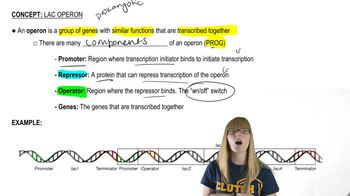The CAP binding site in the lac promoter is the location of positive regulation of gene expression for the operon. Identify what binds at this site to produce positive regulation, under what circumstances binding occurs, and how binding exerts a positive effect.
Table of contents
- 1. Introduction to Genetics51m
- 2. Mendel's Laws of Inheritance3h 37m
- 3. Extensions to Mendelian Inheritance2h 41m
- 4. Genetic Mapping and Linkage2h 28m
- 5. Genetics of Bacteria and Viruses1h 21m
- 6. Chromosomal Variation1h 48m
- 7. DNA and Chromosome Structure56m
- 8. DNA Replication1h 10m
- 9. Mitosis and Meiosis1h 34m
- 10. Transcription1h 0m
- 11. Translation58m
- 12. Gene Regulation in Prokaryotes1h 19m
- 13. Gene Regulation in Eukaryotes44m
- 14. Genetic Control of Development44m
- 15. Genomes and Genomics1h 50m
- 16. Transposable Elements47m
- 17. Mutation, Repair, and Recombination1h 6m
- 18. Molecular Genetic Tools19m
- 19. Cancer Genetics29m
- 20. Quantitative Genetics1h 26m
- 21. Population Genetics50m
- 22. Evolutionary Genetics29m
12. Gene Regulation in Prokaryotes
Lac Operon
Problem 10
Textbook Question
How would a cap⁻ mutation that produces an inactive CAP protein affect transcriptional control of the lac operon?
 Verified step by step guidance
Verified step by step guidance1
Understand the role of the CAP protein in the lac operon: CAP (catabolite activator protein) is a regulatory protein that facilitates the binding of RNA polymerase to the promoter of the lac operon, enhancing transcription. CAP requires cAMP to bind to the DNA at the CAP site.
Recognize the impact of a cap⁻ mutation: A cap⁻ mutation results in an inactive CAP protein. This means that CAP cannot bind to the CAP site on the DNA, even in the presence of cAMP.
Analyze the effect on transcription: Without CAP binding, RNA polymerase has difficulty binding efficiently to the promoter of the lac operon. This leads to reduced transcription of the operon, even when lactose is present and glucose levels are low.
Consider the physiological context: The lac operon is normally activated when glucose is scarce and lactose is available. The cap⁻ mutation disrupts this regulatory mechanism, leading to poor expression of the lac operon regardless of glucose levels.
Conclude the overall effect: The cap⁻ mutation results in a significant reduction in the transcriptional activation of the lac operon, impairing the cell's ability to metabolize lactose efficiently under conditions where it would normally do so.
 Verified video answer for a similar problem:
Verified video answer for a similar problem:This video solution was recommended by our tutors as helpful for the problem above
Video duration:
4mPlay a video:
Was this helpful?
Key Concepts
Here are the essential concepts you must grasp in order to answer the question correctly.
CAP Protein Function
The CAP (catabolite activator protein) is a transcription factor that enhances the expression of certain genes, including the lac operon, in response to low glucose levels. When glucose is scarce, CAP binds to cyclic AMP (cAMP), forming a complex that promotes RNA polymerase binding to the promoter of the lac operon, facilitating transcription.
Recommended video:
Guided course

Proteins
Lac Operon Structure
The lac operon is a set of genes in E. coli that are involved in the metabolism of lactose. It consists of three structural genes (lacZ, lacY, and lacA) and regulatory elements, including the promoter and operator. The operon is typically off when glucose is present but can be activated in the absence of glucose, allowing the bacteria to utilize lactose as an energy source.
Recommended video:
Guided course

Lac Operon Overview
Transcriptional Control Mechanisms
Transcriptional control mechanisms regulate gene expression in response to environmental changes. In the case of the lac operon, the presence of glucose inhibits cAMP production, leading to reduced CAP-cAMP complex formation. A cap⁻ mutation that produces an inactive CAP protein would prevent this activation, resulting in decreased transcription of the lac operon, even when lactose is available.
Recommended video:
Guided course

Eukaryotic Transcription
Related Videos
Related Practice
Textbook Question
610
views


